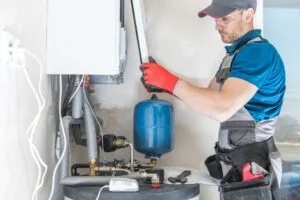Go Green With Eco-Friendly Heating Systems In Kansas City
As a homeowner in Kansas City, staying warm in the colder months is essential for maintaining a comfortable living environment. However, traditional heating systems can contribute to increased energy consumption and a larger carbon footprint, impacting both your utility bills and the environment. Today, many homeowners are seeking eco-friendly heating options that can keep their homes comfortable without compromising their commitment to sustainability.
In this article, we will explore various energy-efficient heating solutions that are not only environmentally responsible but also effective in providing reliable warmth during the chilly winters.
Climate Control Heating, Cooling & Plumbing, your trusted provider for heating, cooling, and plumbing services in Kansas City, will guide you through the benefits and features of these eco-friendly heating alternatives, helping you make an informed decision for your home’s heating needs.
Maintain Proper Ventilation And Air Circulation
To improve indoor air quality, one of the first steps is to ensure adequate ventilation and air circulation throughout your home. This can help to reduce concentrations of pollutants and allergens, making the air safer for your newborn or young child.
Make sure your HVAC system is working efficiently and in good condition, and be sure to change filters regularly — ideally, every one to three months. Additionally, consider using exhaust fans in the kitchen, bathroom, and laundry room to help remove moisture and contaminants.
Another effective ventilation strategy is to allow fresh air into the home by opening windows and doors for a few minutes each day, weather permitting. However, be cautious during high pollen count seasons, as this may exacerbate allergies for sensitive individuals.
Keep The Humidity In Check
Maintaining optimal humidity levels in your home is crucial for indoor air quality. High humidity can encourage the growth of mold and mildew, which can be harmful to a child’s respiratory system. On the other hand, low humidity can cause dry skin, nasal congestion, and other discomforts. The ideal indoor humidity level is between 30% and 50%.
To help control humidity:
- Use a dehumidifier in damp areas, especially basements.
- Place a humidifier in your child’s room during dry months or use a whole-house humidifier integrated into your HVAC system.
- Utilize exhaust fans or open windows when showering or cooking to reduce excess moisture.
- Repair any leaks or water damage promptly to prevent mold growth.
Regular Cleaning Habits
Keeping your home clean plays a significant role in maintaining good indoor air quality. Develop a routine cleaning schedule to help keep dust, pollen, and other airborne irritants at a minimum.
Some cleaning tips include:
- Vacuum carpets and upholstered furniture at least once a week, using a vacuum equipped with a HEPA filter to trap allergens effectively.
- Mop hard floors to pick up any dust left behind by vacuuming. Use a microfiber or electrostatic mop for the best results.
- Dust surfaces regularly, paying close attention to shelves, window sills, and other flat surfaces where dust can settle. Use a damp cloth to capture and remove dust particles effectively.
- Wash your child’s toys, bedding, and clothes regularly in hot water to eliminate allergens.
- Consider using an air purifier in high-traffic rooms to help remove airborne contaminants.
Choose Baby-Safe Cleaning Products
Many conventional cleaning products contain harsh chemicals that can negatively impact indoor air quality and be harmful to your child. Opt for natural, eco-friendly cleaning products, or make your own using non-toxic ingredients such as vinegar, baking soda, and lemon.
Avoid using products containing volatile organic compounds (VOCs), which can emit toxic gases and contribute to respiratory irritation. Also, steer clear of heavily fragranced cleaning products, as synthetic fragrances can be respiratory irritants for sensitive individuals, including infants and young children.
Be Conscious Of Your Home’s Furnishings And Materials
Many household materials and furnishings, such as carpets, furniture, and paint, can emit VOCs that negatively affect indoor air quality. When renovating or furnishing your home, choose low-VOC paints and adhesives and opt for hard-surface flooring like wood, tile, or laminate, which are less likely to harbor allergens than carpets. If you prefer the comfort of carpets, choose low-pile options and vacuum them regularly.
When purchasing new furniture or decor, look for items made of eco-friendly, non-toxic materials, and allow them to “off-gas” outdoors or in a well-ventilated area before bringing them into your home to reduce potential exposure to harmful chemicals.
Monitor And Address Sources Of Indoor Allergens
By identifying and addressing the sources of indoor allergens, you can help improve the overall air quality in your home. Common allergens include pet dander, dust mites, mold, and pollen. Here are some ways to combat household allergens:
- Minimize clutter to reduce dust collection.
- Use allergen-proof covers for pillows, mattresses, and box springs.
- Groom pets regularly and keep their sleeping areas clean.
- Use a dehumidifier or air conditioner to maintain the recommended humidity levels and inhibit mold growth.
- Keep windows closed during days with high pollen counts.
Breathe Easy With Climate Control Heating, Cooling & Plumbing’s Expert Assistance
Ensuring a healthy indoor air quality goes a long way in creating a safe and nurturing environment for your newborns and young children. By implementing the tips and strategies mentioned in this article, you’ll be well on your way to cultivating a home that supports the health and well-being of your entire family.
For further guidance and insight, rely on the expertise of Climate Control Heating, Cooling & Plumbing. Our team of skilled professionals is dedicated to helping families achieve the highest levels of indoor air quality, comfort, and safety.
Contact Climate Control Heating, Cooling & Plumbing today to schedule a professional assessment of your home’s air quality or a cooling and heating replacement in Kansas City, MO!





